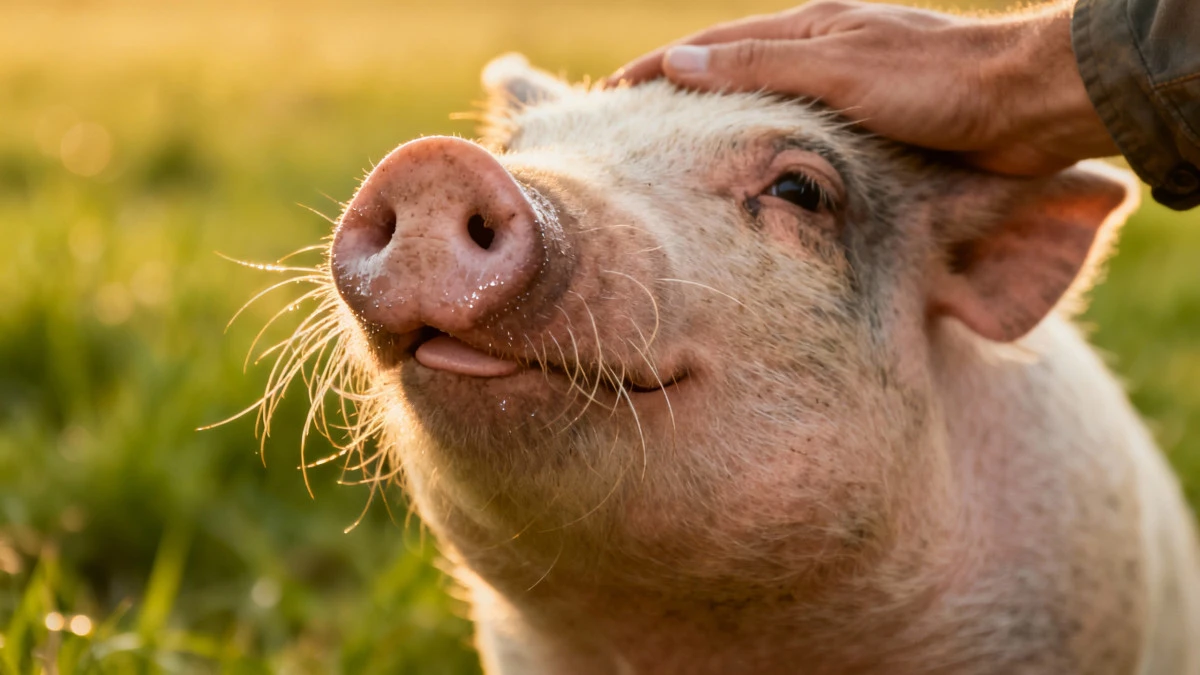What’s in a “Oink”? A Symphony of Pig Sounds
Just like cows “moo” and horses “neigh,” pigs boast their own special cries. Traditionally, we call it “grunting” or “squealing.” Those sounds, guttural and deep or sometimes rough, are just the beginning. A domestic pig’s voice box isn’t limited to just two types of vocalizations – far from it! In reality, pigs produce a wide range of sounds, from high-pitched squeals to low, rumbling growls.
Researchers from INRAE (the French National Research Institute for Agriculture, Food and the Environment) have catalogued more than twenty different vocalizations. Each one expresses a different emotion or context: fear, pain, contentment, foraging, social play—you name it. And when people say pigs are noisy, it’s no exaggeration. Sound levels have been measured at up to 115 decibels, roughly equivalent to a rock concert. Not bad for a barnyard animal!
The Science Behind the Snort: How Pigs Make Their Noise
When we humans try to imitate a pig, we often end up snorting through our throats or wiggling our noses. But the pig’s real sound-making strategy is far more sophisticated. Pigs possess a larynx and vocal cords much like other mammals, but it’s the unique structure of their throat (the pharynx) and the sheer power of their chest that produces such a deep, sometimes ear-splitting resonance. So while “oink oink!” may entertain kids, the true voice of the pig is much richer and more complex than that caricature.
When pigs experience negative emotions—think fear or pain—they let out long, scream-like or piercing squeals. In contrast, when they’re comfortable or just going about normal social life, the sounds are shorter: grunts or sharp little barks. These are often paired with ear movements or a wagging tail.
Grunting isn’t just a sign of discomfort; it also appears in positive situations like searching for food, interacting socially, or maintaining group contact. Subtle nuances create what amounts to a real “sound grammar” for pigs.
Beyond Noise: Intelligence, Emotion, and Communication
The soundscape of the pig reveals a diverse tapestry of behaviors and emotions. Reducing pigs to noisy bellies or curious snouts does them a disservice—behind those grunts hides an animal of remarkable intelligence.
Multiple scientific studies have shown that domestic pigs can learn complex tasks, remember solutions, and even solve problems. They can manipulate objects with their snouts, recognize themselves in mirrors, distinguish symbols, and even use a joystick to move a cursor on a screen. These abilities put pigs among the brainiest mammals, right up there with dogs—and even dolphins.
In 2022, researchers unveiled a special algorithm developed for the SOUNDWEL project. This tool analyzed 7,414 recordings from 411 pigs, mapping out precise sound patterns linked to emotions and life stages, from birth to slaughter. The idea is both simple and revolutionary: by analyzing pigs’ voices, we can gauge their emotional state and health. So, understanding pig calls isn’t just a curiosity—it’s a practical matter for modern farming.
In some experimental farms, sound sensors record pigs’ noises around the clock. By analyzing these, farmers can detect early warnings of stress, respiratory disease, or feeding issues. What might seem like just another grunt actually becomes a vital indicator of animal welfare. This approach paves the way for a more respectful relationship with farm animals, where listening to their sounds becomes a central tool for their care and management.
Pigs as Models: From Health to Companionship
The pig’s vocal apparatus is so similar to ours that researchers use it to study human voice and respiratory disorders. By analyzing pig breathing and the mechanics of their vocal cords, scientists improve their understanding of human conditions, and some even test experimental treatments or larynx transplants with pig tissue. The grunts that might seem merely loud are actually keys to bettering human health.
Beyond their voice, pigs are also captivating subjects in cognitive science. Their abilities to remember routes, recognize symbols and individuals, and cooperate to achieve goals continue to fascinate scientists. In some experiments, pigs have even displayed anticipation and empathy, reacting to the stress of a fellow pig. This intelligence, long underestimated, is shifting the way people view these farm animals, and it prompts questions about how they’re treated.
Of course, while many know pigs as farm animals, some have welcomed them into their homes. Certain miniature breeds, like the Vietnamese pot-bellied pig or the Göttingen mini pig, have made their way into households. Intelligent and sociable, these pigs make affectionate pets who can recognize their name, learn basic tricks, and form genuine bonds with their owners.
But let’s not get carried away—a pig, even a mini one, is no easy pet. They require space, mental stimulation, and a specialized diet. Still, every adoption is a reminder: behind those sometimes thunderous grunts lies a sensitive, communicative, and curious being.

